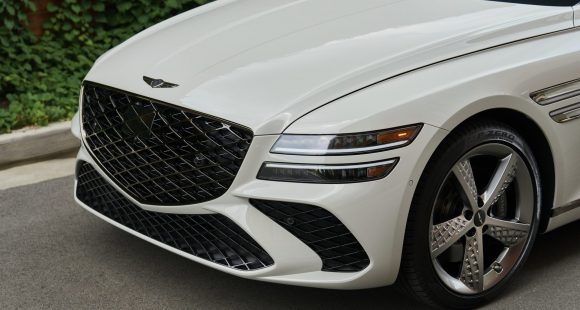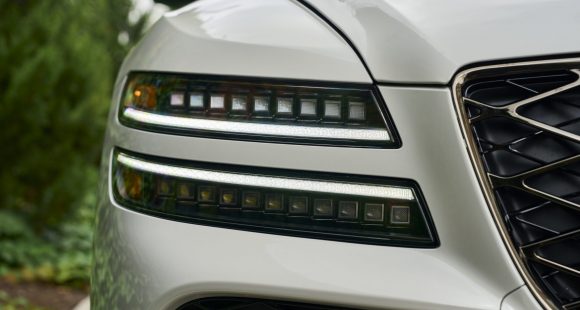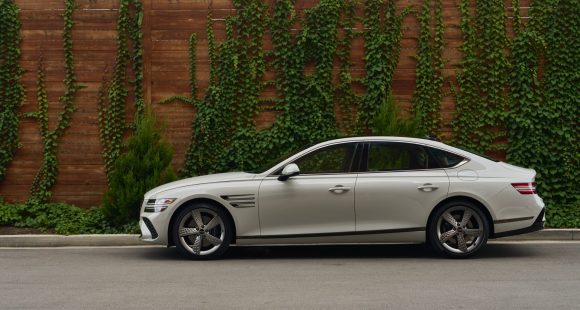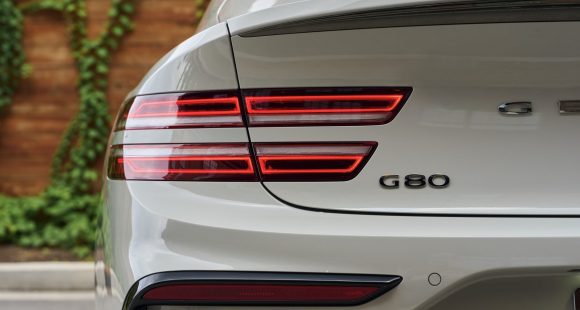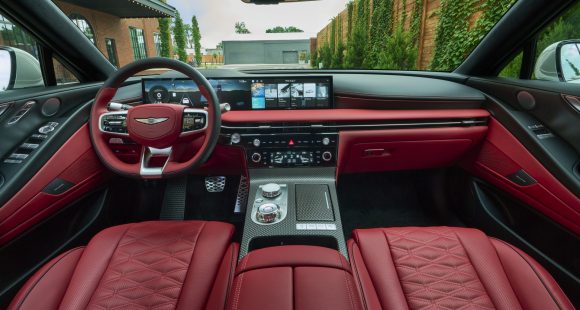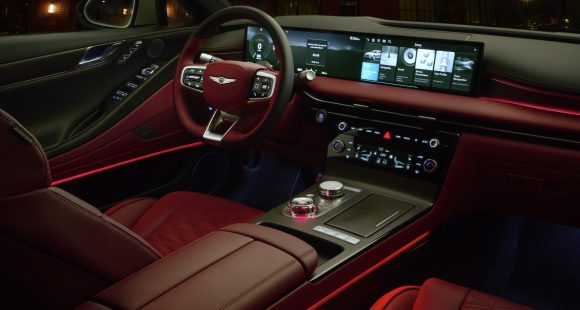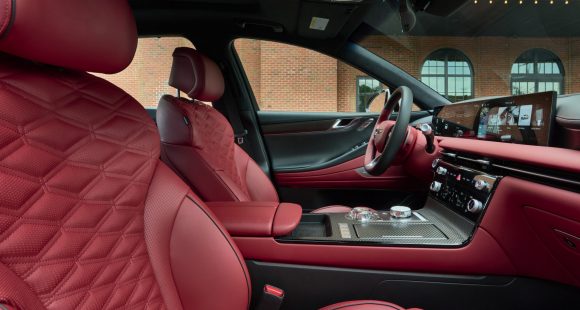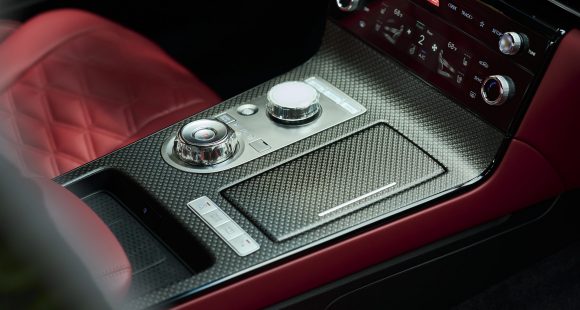2010 Ford Shelby GT500
Carroll Shelby and Ford Mustang. Two names that together have defined American muscle cars for an amazing 45 years. And this is their latest effort, the 2010 Ford Shelby GT500. With fresh hardware from Ford, and fresh inspiration from Shelby, it’s once again poised to conquer just about anything covered with asphalt. So, let’s get to it!
The story of the Ford Shelby GT500 began in 1967 with a menacing double dose of power and style. Four decades later, in 2007, Carroll Shelby’s masterpiece was reborn in 21st century fashion. And for 2010, the Ford-Shelby partnership grows stronger as the latest GT500 is meaner than ever.
Pumping this stallion’s heart blood is the SVT limited edition GT500KR’s 5.4-liter Supercharged V8. Horsepower is up 40 to 540, and torque is up 30 to 510 pound-feet over the previous model. Peak output comes from an intercooled roots-type supercharger, now with nine pounds of added boost.
Sending heaps of power to a shorter 3.55 limited slip rear diff is a re-geared six-speed manual with its iconic cue ball shifter.
 Down the long from straight of Savannah’s Roebling Road raceway, our Mustang roared to 60 in 4.5 seconds, and swallowed up the quarter mile in 12.9 seconds at 112 miles per hour. The GT500’s fat power band delivers full tilt power all the way. The exhaust growl combined with the supercharger whine doesn’t just sound scary, it’s flat-out nightmarish.
Down the long from straight of Savannah’s Roebling Road raceway, our Mustang roared to 60 in 4.5 seconds, and swallowed up the quarter mile in 12.9 seconds at 112 miles per hour. The GT500’s fat power band delivers full tilt power all the way. The exhaust growl combined with the supercharger whine doesn’t just sound scary, it’s flat-out nightmarish.
New SVT suspension tuning was aimed at improving the car’s dynamics. Also to help, new Goodyear F1 Supercar tires on special alloy wheels–19-inchers on the coupe, 18s on the convertible. Stability control is newly standard too, with normal and Sport modes, but can also be turned off.
But even with enhancements, the GT500's full throttle handling remains generally mediocre, especially compared to the Corvettes and Porsches of the world. In Roebling's tight turns, it comes off big and lumbering. With a minimum 3,900-pound curb weight, and relatively soft springs, we were surprised by so much front push and body roll.
But, back off a bit, say to about 80 percent max power, and everything changes. Now the GT500 maneuvers beautifully. Turn-ins are crisp and steering is very responsive. The GT500's power lets you blast out of corners, and the rear can easily be coaxed out by throttle with the ESP off. Also, the shifter works great on the track. Its pattern is tight and just right. And the pedal setup is perfect for "heel and toe" driving.
So, it's only when you push this pony car toward its limits that it scares you off. But that disappointment in a track test makes it one secure high performance car for the street. Indeed, the Shelby GT500 is the ideal backroad entertainer, and when the pavement gets rough, it won't shake your fillings loose like most track stars.
In terms of reeling it all in, the GT500's four-wheel disc ABS setup uses Brembo four-piston calipers up front. Stops were stable and averaged 130 feet, which is OK, but we expected better. Now onto the aggressive cosmetics, always a big part of a Shelby named effort. Most obvious are the signature twin racing stripes, now newly available on the droptop version.
For a meaner front-end, the hood and front fascia now shroud the waffled grille and lower air intake. The coiled Cobra is still there, but new is the front splitter and optional auto headlights. Follow the sharp but broken shoulder line back to a new lower-drag "Gurney Flap" rear spoiler and dual four-inch stainless exhaust tips.
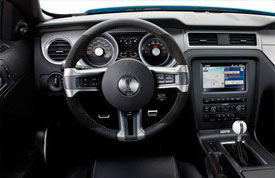 Inside, the familiar four-seat twin-cockpit Mustang cabin is more refined than ever. This classic interior now displays far better materials and craftsmanship. The instrument panel features real aluminum to highlight the SVT-style gauge cluster. Sport seats are leather with embroidered snakes and new Alcantara racing stripe inserts that mimic those on the exterior.
Inside, the familiar four-seat twin-cockpit Mustang cabin is more refined than ever. This classic interior now displays far better materials and craftsmanship. The instrument panel features real aluminum to highlight the SVT-style gauge cluster. Sport seats are leather with embroidered snakes and new Alcantara racing stripe inserts that mimic those on the exterior.
The beefy three-spoke steering wheel wears a hissing snake as well. New technology for the GT500 includes Ford Sync with 911 Assist, as well as an SOS Post-Crash Alert System. And the standard Shaker stereo with CD-changer provides high octane tunes to accompany some serious performance driving. Being a Mustang, the GT500 does have rear seats, but they're way too tight for pretty much any adult to be comfortable.
But here's a surprise-Government Fuel Economy Ratings are 14 city/22 highway. So even with more power, the highway rating is 10% greener than last year. As to how much green you need to lay down, the Shelby GT500 starts at $48,575 for the coupe, and $53,575 for the convertible, which includes a $1000 gas guzzler tax. That's more than a base Corvette, but way less than a 911 or a Viper.
It's fast, it's mean, and it's historic. The 2010 Shelby GT500 is modern Detroit muscle in its purest form. On the track, we admit, it doesn't feel quite at home. But anywhere else, everywhere else, this classic beast rules the roads.Specifications
- Engine: 5.4-Liter Supercharged V8
- Horsepower: 540
- Torque: 510 Lb Feet
- 0-60 MPH: 4.5 Seconds
- 1/4 Mile: 12.9 Seconds @ 112 MPH
- 60-0 MPH: 130 Feet
- EPA: 14 MPG City/ 22 MPG Highway
2025 Genesis G80
New Interior And New Tech Elevates G80 Sedan
Talk about bad timing. This second-generation G80 debuted at the height of a global pandemic. But that hasn’t stopped Genesis or this Bentley-on-a-budget sedan. In fact, since then, Genesis has unveiled a spectacular all-electric version and now given all G80s a makeover. So, let’s find out what a better and better-timed new G80 is ready to deliver.
Breaking into the luxury sedan scene requires going up against traditional brands with long pedigrees and legions of loyal buyers. But Hyundai has never shied away from a challenge, and has made steady progress with their Genesis brand, and hopes that a revised 2025 G80 midsize sedan will be their next step up.
Styling matters more when you’re the upstart, and the Genesis Athletic Elegance theme changes very little for ’25; just a new grille, slightly reshaped bumpers, new wheels ranging from 18 to 20 inches, and an updated color palette. The G80’s unique two-line LED headlamps get revised Micro Lens Array technology that boosts performance while minimizing the brightness for oncoming drivers.
Changes inside are much more significant with an entirely new dash and console, eliminating both the hooded gauge panel and dashtop wide info screen. Merging them together into one 27-inch wide LG panoramic display than runs from behind the steering wheel to over the center stack. There’s a bigger and more comprehensive control panel in the center stack; while the console gets less armrest coverage, more space for storage, and reshaped cupholders. The wider display is still a touchscreen, but there is also a console mounted controller if you prefer to keep it fingerprint free. Both options work well, but the controller is still too easy to confuse with the dial-like shifter.
Materials are on par if not a notch above most European luxury rivals, and there are 18 speakers to crank out 1,400 watts of premium sound from Bang & Olufsen. Top Sport Prestige trim comes with Nappa leather seats, carbon fiber trim, micro-suede materials for the headliner and pillar covers, heated armrests, head-up display, and upgraded active safety features. Front seats are immensely comfortable without feeling overly soft, and there’s plenty of comfort and room for adults in the back seat.
More Bentley than Benz; streaking down the track with European-style solidity that gives you very little indication of the high speed you’re traveling at.
Same powertrains as last year. Base power comes from a 300-horsepower 2.5-liter turbo-four; the upgrade is this 3.5-liter twin-turbo V6 that outputs 375 horsepower and 391 lb-ft of torque. Both are hitched to standard all-wheel drive. At our Mason Dixon Dragway test track, the AWD delivered enough grip for consistent slip-free launches. We hit 60 in 5.0 seconds flat. Run after run, the 3.5T pulled as strong as it sounds. All G80s work with the same paddle-shift eight-speed automatic transmission, and while shifting was silky smooth on the street, here on the track with Sport Mode and wide-open throttle they were noticeably firmer and quicker.
It was a very surreal experience in the cabin. More Bentley than Benz; streaking down the track with European-style solidity that gives you very little indication of the high speed you’re traveling at. For us, that was 105 mph in 13.4 seconds at the quarter. In addition to the G80’s Sport Mode that tightens steering, improves throttle response, adjusts shifting points, firms up the suspension, and reconfigures stability system parameters; Sport Prestige trim adds rear-wheel steering and an electronic limited slip differential. But, even with all of that, it didn’t feel overly sporty in our handling course. Now, we were able to comfortably carry quite a bit of speed through the cones, but there was just an overall soft, somewhat disconnected and heavy presence that had us unsure of how hard we could push. Sport Prestige also adds upgraded performance brakes. They were plenty capable, bringing this 4,600-lbs. luxury liner consistently down from 60 in just 104 feet with little fade.
Government Fuel Economy Ratings for the six-cylinder are 16 City, 24 Highway, and 19 Combined. We averaged a good 21.3 mpg of Premium. Still, that’s a slightly below average Energy Impact Score, using 15.7 barrels of oil annually with 7.8 tons of CO2 emissions.
Considering the amount of luxury packed into the G80, its $58,350 starting price, even though slightly higher than last year, remains pretty remarkable. It’s a substantial step up to the 3.5T though, as it begins at $70,850.
Genesis has existed as a standalone luxury brand for just less than a decade, and it has indeed been making steady progress into what is surely the hardest segment of all to master. The 2025 Genesis G80 sedan continues to impress and is a great option for luxury-minded buyers who prioritize true value over badges.
Specifications
As Tested
- Engine: 3.5-liter twin-turbo V6
- Transmission: eight-speed automatic
- Horsepower: 375
- Torque: 391 lb-ft
- EPA: 16 City | 24 Highway | 19 Combined
- 0-60 mph: 5.0 seconds
- 1/4 Mile: 13.4 seconds at 105 mph
- Braking, 60-0 (avg.): 104 feet
- MW Fuel Economy: 21.3 mpg (Premium)















